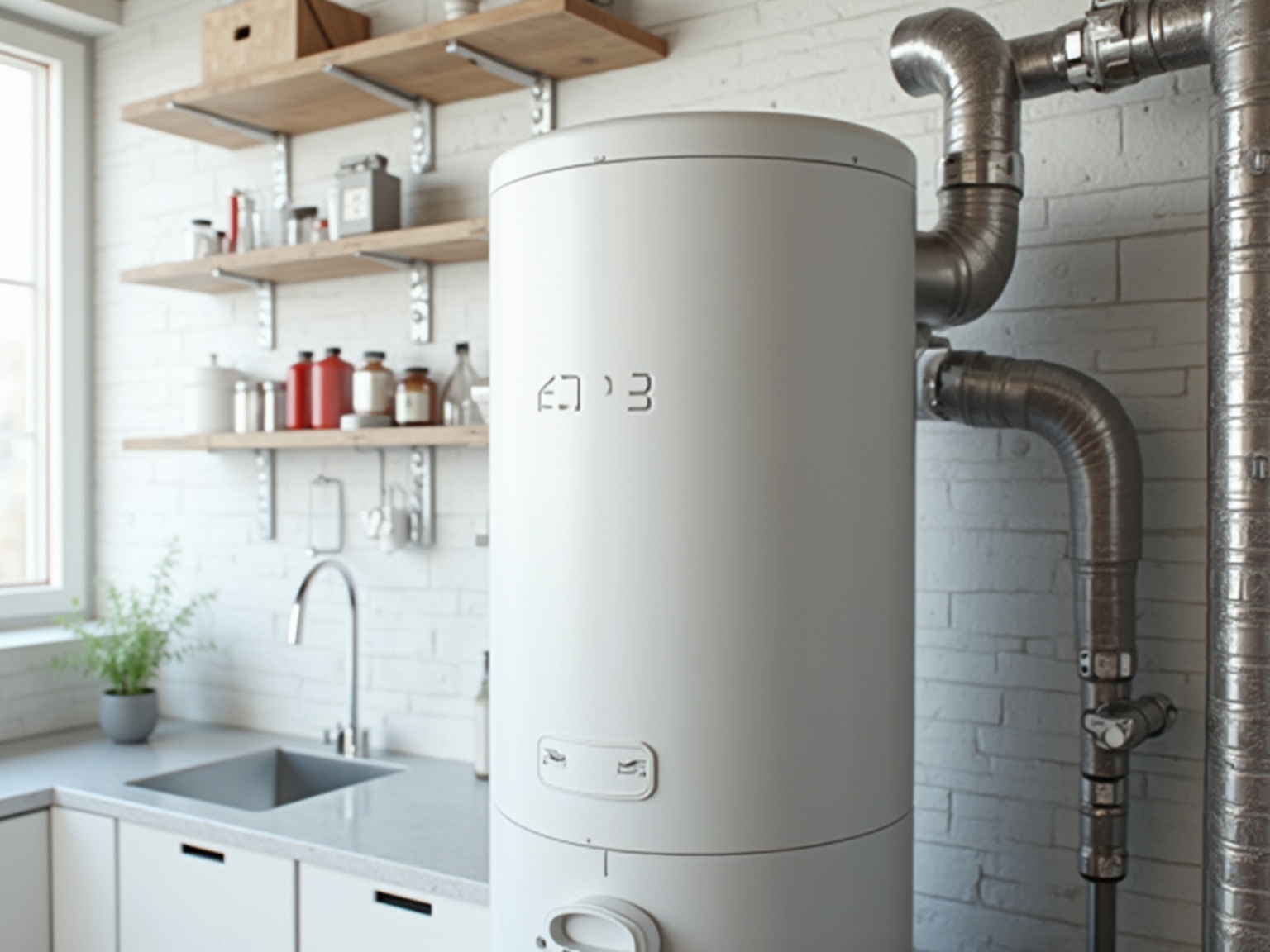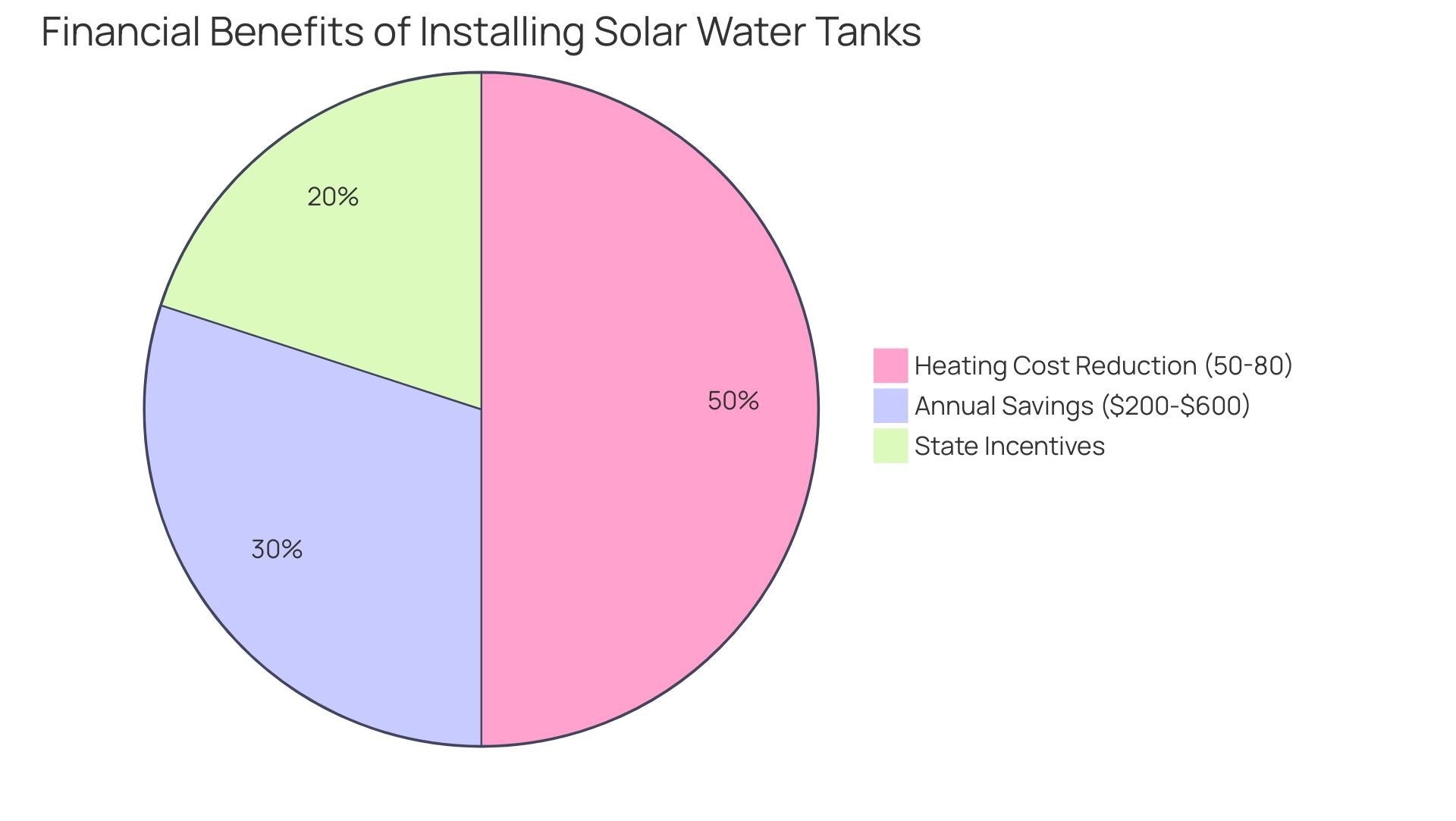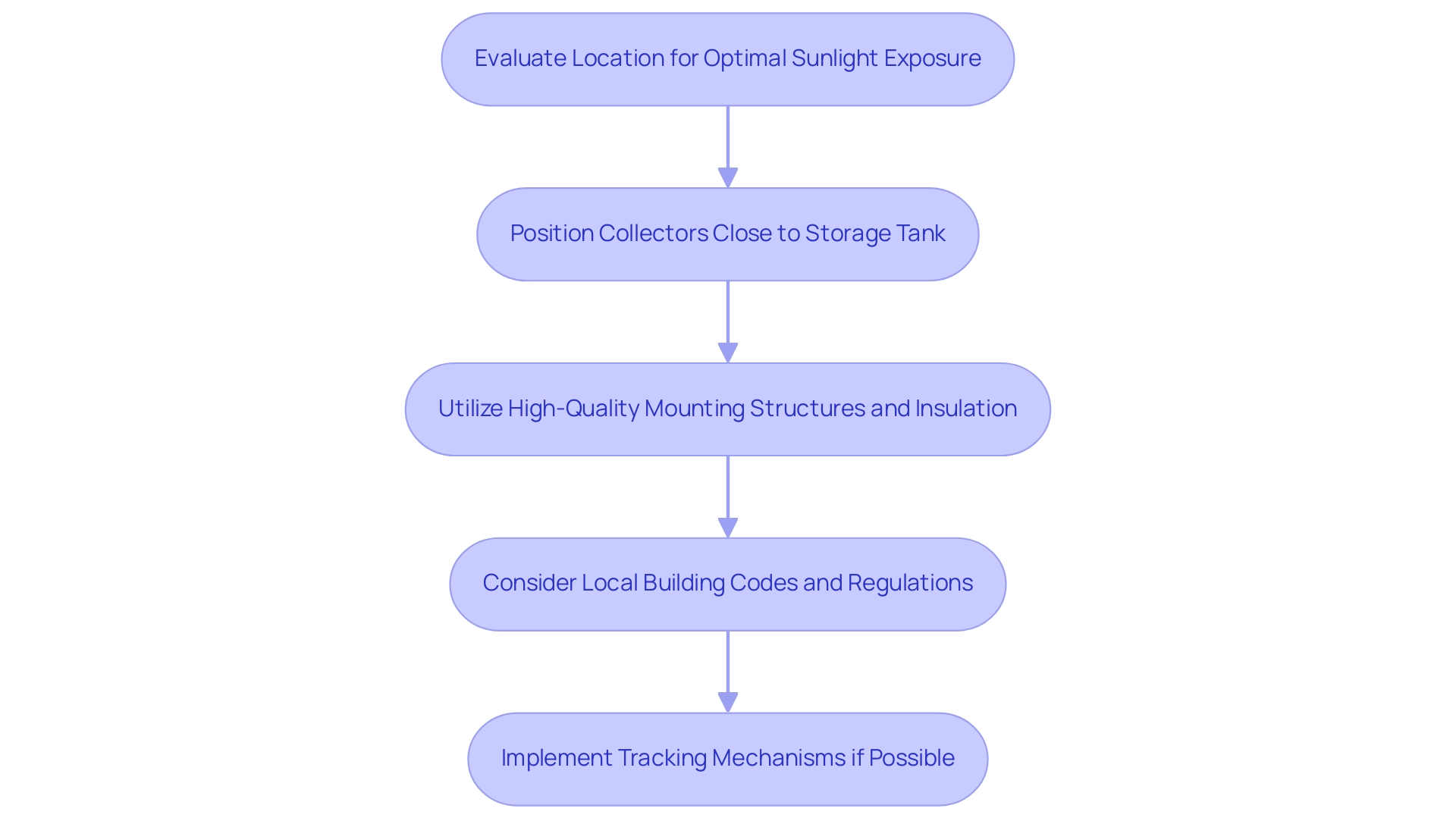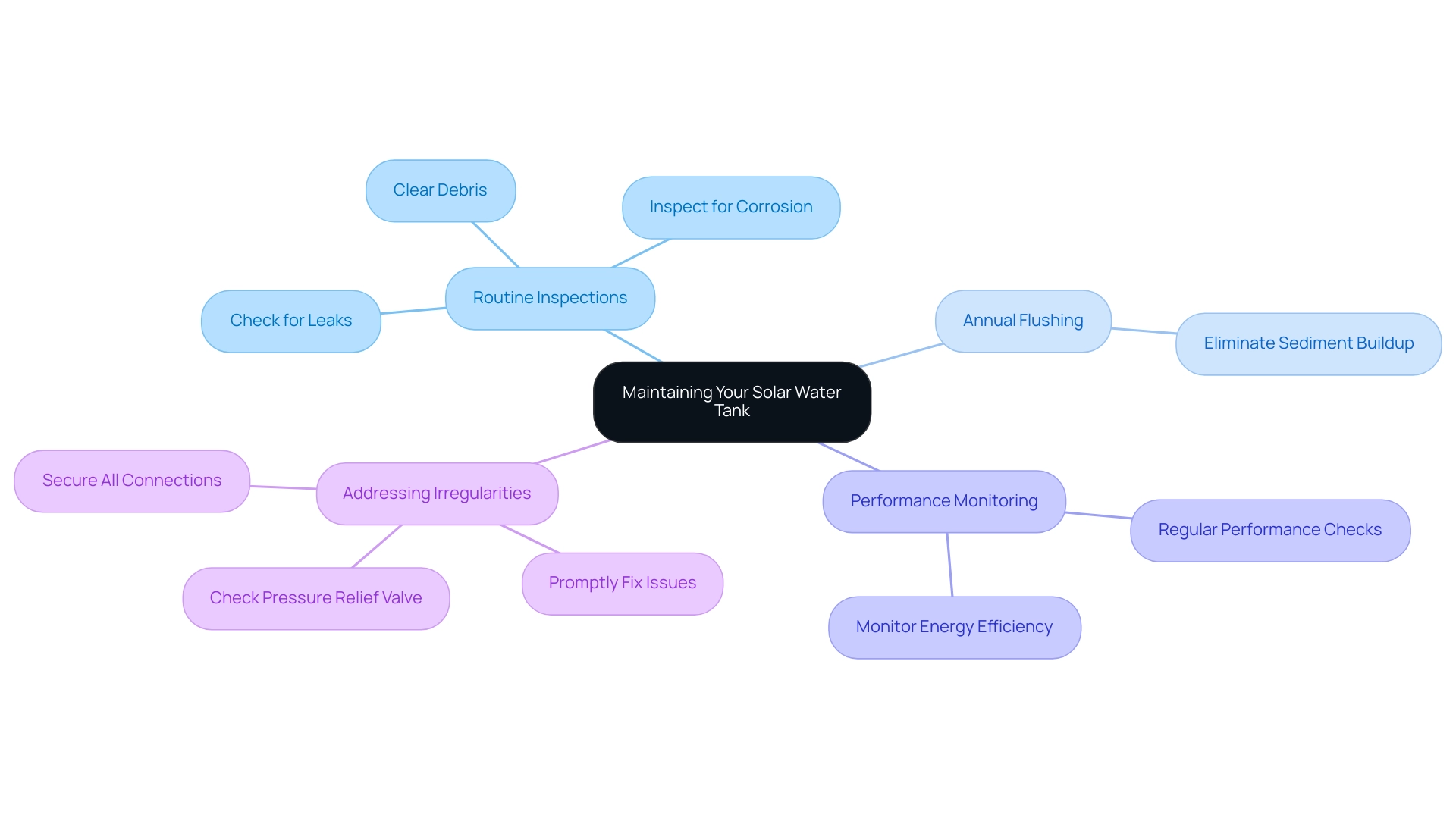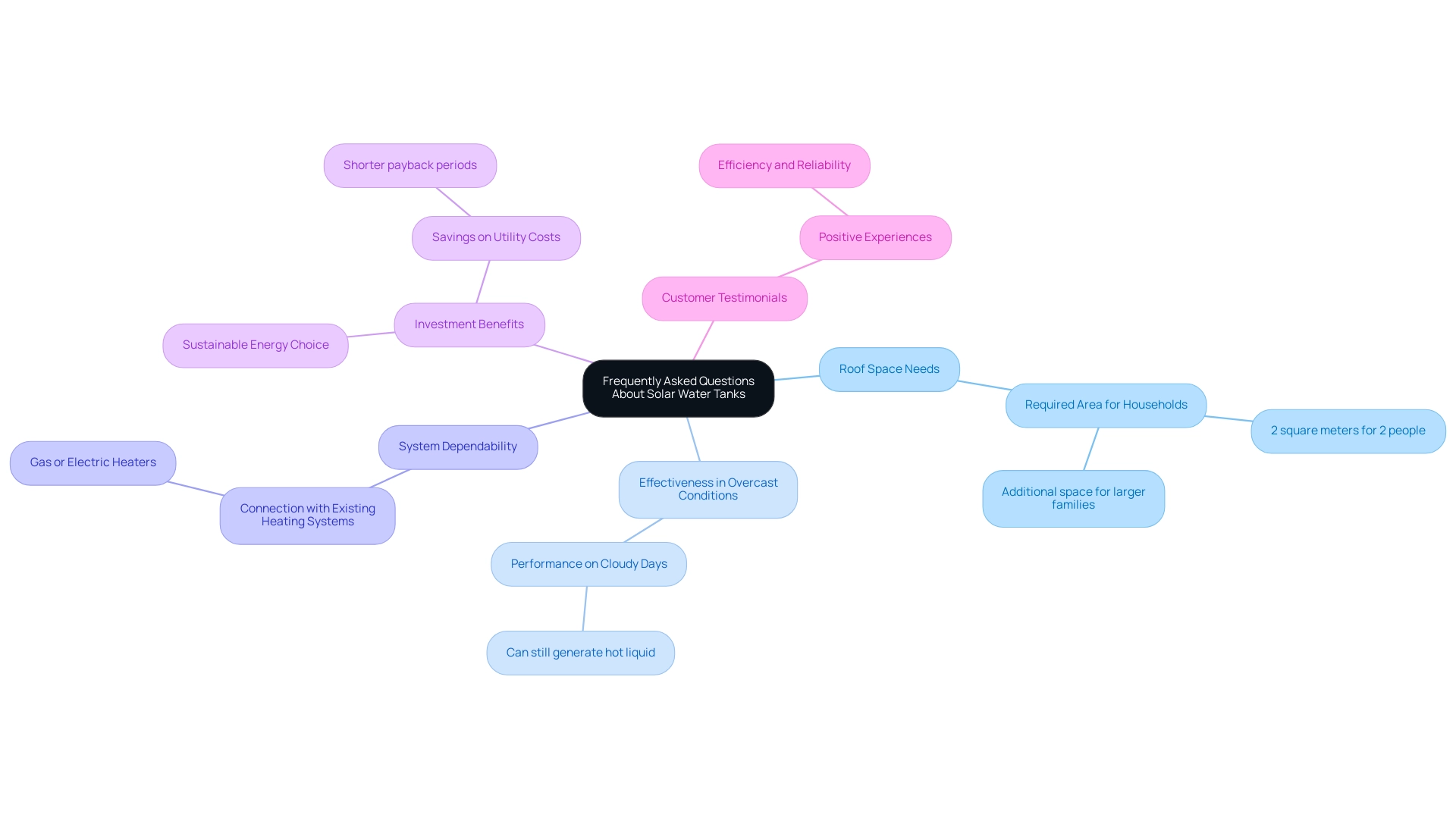Overview
We understand that rising energy bills can be a significant concern for homeowners. Solar water tanks offer a compassionate solution, designed to capture and store heat from sunlight, ultimately providing an efficient and sustainable way to heat water in your home. Not only do these systems significantly reduce utility costs—by as much as 80%—but they also foster energy independence and sustainability. With advancements in technology and available financial incentives, solar water tanks are becoming increasingly attractive to those seeking to make a positive impact on both their finances and the environment.
Imagine the peace of mind that comes from knowing you’re taking control of your energy usage. By embracing solar energy, you’re not just cutting costs; you’re making a meaningful commitment to a sustainable future. Together, we can work towards reducing our reliance on traditional energy sources, creating a healthier planet for generations to come.
If you’re curious about how solar water tanks can benefit your home and lifestyle, we invite you to reach out. Let’s explore this journey towards energy independence together, ensuring you feel supported every step of the way.
Introduction
In a world where many of us are increasingly concerned about rising energy bills and the need for sustainability, solar water tanks emerge as a beacon of hope and innovation. These advanced systems are thoughtfully designed to capture and store solar energy, offering a reliable source of hot water while significantly lowering your utility costs. As technology evolves and awareness expands, the advantages of solar water heating systems become clearer, with efficiency rates soaring and financial incentives making them even more appealing.
We understand that reducing your carbon footprint and fostering energy independence are important to you. Solar water tanks are not just a wise investment for homeowners—they represent a crucial step towards a more sustainable future for all of us.
This article explores the mechanics, benefits, and best practices associated with solar water tanks, providing insights that empower you to make informed decisions about your energy needs. Together, we can embrace a brighter, more sustainable future.
What Are Solar Water Tanks and How Do They Work?
We understand that rising energy bills can be a significant concern for many homeowners. Solar water tanks offer a nurturing solution, designed to capture and hold heat produced from renewable energy. These innovative thermal storage systems are typically well-insulated, ensuring that hot fluid remains available for use even during periods without sunlight. The process begins with collectors that capture sunlight and transform it into heat, providing a sustainable way to meet your heated liquid needs.
In 2025, advancements in sunlight heating technology have significantly improved efficiency and performance. Recent statistics indicate that heating systems utilizing sunlight can achieve efficiency rates exceeding 80%. This makes them a practical choice for homeowners seeking to lower utility expenses while being kind to the planet. Furthermore, the Inflation Reduction Act has strengthened the renewable energy sector, providing tax credits that enhance long-term certainty for installations. This has led to a projected 46% increase in deployment compared to previous estimates, a promising sign for those considering a shift.
It’s encouraging to see that large firms such as Amazon, Google, and Meta possess a combined contracted pipeline exceeding 25 GW, highlighting the increasing momentum in the renewable sector.
Real-world instances from California demonstrate the efficiency of solar water tanks for heating. For example, a community in Roseville adopted a solar water tank as a thermal heating solution that not only lowered utility costs but also supported the sustainability of the local grid. This case study illustrates how Powercore Electric, with its strong community focus and commitment to transparency, has played a pivotal role in facilitating such installations.
Their internal group of specialists guarantees top-notch installations and upkeep, making the solar water tank a dependable power source, especially in areas with ample sunlight.
As property owners contemplate shifting to renewable solutions, comprehending the mechanics and advantages of a solar water tank is crucial. These systems promote energy independence and align with the growing trend toward sustainable living, making them an attractive option for eco-conscious homeowners. Key factors for choosing the best heater include evaluating:
- Regional climate
- Household requirements
- Budget
- Installation simplicity
- The First Hour Rating (FHR), which measures the quantity of hot fluid a heater can provide in the first hour of operation.
Investing in a renewable heating system not only provides cost savings and decreases greenhouse gas emissions but also aids equitable access initiatives, contributing to a more sustainable future. To assist potential buyers, it is important to consider specific product specifications such as the size and capacity of the solar water tank, as well as the materials used in its construction. Pricing details are also essential; for instance, the typical expense of a heating apparatus can vary from $3,000 to $7,000, based on the dimensions and intricacy of the setup.
Customer testimonials from satisfied users of Powercore Electric’s services can further illustrate the benefits and reliability of these systems, enhancing the overall appeal for prospective buyers. Together, we can work towards a more sustainable and energy-independent future.
The Benefits of Installing Solar Water Tanks
Installing thermal reservoirs can truly transform your home, especially when it comes to saving money and accessing financial assistance. Many homeowners are pleasantly surprised to find that they can reduce their heating costs by an impressive 50% to 80%. This translates to annual savings of $200 to $600, significantly easing the burden of rising utility bills that many of us face.
We understand that financial concerns can weigh heavily on your mind. That’s why it’s worth noting that state incentives, such as tax credits and storage rebates, can further enhance these savings, making thermal tanks an even more attractive investment for homeowners like you. Numerous case studies reveal that households embracing heating technologies have reported remarkable reductions in their utility bills, with some even enjoying savings that surpass their initial expectations.
Moreover, water heating systems play a crucial role in fostering self-sufficiency by lessening our reliance on traditional power sources. By harnessing renewable energy, these solutions not only lead to substantial cost savings but also champion sustainability—an ideal choice for environmentally conscious homeowners. As Ben Zientara, a Solar Policy Analyst, insightfully points out, “One area where states can help bolster demand for renewable energy is incentives,” underscoring the vital role of financial support in encouraging adoption.
Practical examples illustrate the effectiveness of thermal heating solutions. Many homeowners have shared their stories of significant reductions in utility bills post-installation, expressing satisfaction with both the financial benefits and the positive environmental impact of their choices. For instance, a household in Southern California experienced a remarkable drop in utility costs after installing a thermal heating system, positively contributing to their sustainability efforts by lowering their carbon footprint.
Looking ahead, the energy savings from sunlight heating systems are expected to grow even more substantial by 2025, as advancements in technology and increased awareness of renewable energy solutions continue to drive adoption. The 2025 Renewable Energy Industry Survey reflects a sense of optimism for growth in this sector, despite facing challenges such as permitting issues and customer acquisition. This context enhances the benefits of installing solar water tanks, which offer more than mere cost savings; they represent a commitment to a sustainable future, resonating with the rising trend of eco-conscious living.
However, it’s important to acknowledge the recent decline in residential installations within the renewable energy sector, which saw a 4% decrease in Q3 2024. This underscores the urgency for homeowners to consider alternative solutions like solar water tanks to mitigate rising utility expenses and power disruptions, ensuring that we remain proactive in this evolving energy landscape. Additionally, Powercore Electric offers competitive pricing and financing options for solar heating solutions, making the transition to renewable energy more accessible for homeowners.
The effectiveness of these systems can vary based on regional climate; for example, homes in sunnier areas often enjoy greater efficiency than those in cooler climates. Together, let’s explore how these solutions can not only benefit your wallet but also contribute to a healthier planet.
Exploring Different Types of Solar Water Heating Systems
When it comes to managing energy bills, many homeowners are understandably concerned about rising costs. Solar heating installations offer a promising solution, classified into two main types: active and passive systems. Active setups utilize pumps to circulate a heat transfer fluid through solar collectors, which enhances efficiency and performance. On the other hand, passive methods rely on natural convection to transport liquid, making them simpler and often more cost-effective.
As you explore these options, consider the following choices:
- Direct Circulation Systems: Perfect for climates where temperatures rarely dip below freezing, these systems transfer liquid directly from your home to the collectors and back, providing instant hot water.
- Thermosiphon Mechanisms: These setups leverage the natural rise of heated fluid, making them effective in warmer climates. They feature a storage tank positioned above the solar collectors, allowing heated liquid to flow naturally into the tank.
- Drain-Back Units: Tailored for colder climates, these units use a pump to circulate liquid through the collectors, which drains back into a storage tank when not in use, protecting against freezing.
Understanding these choices is crucial for selecting the right setup for your home. Looking ahead to 2025, the market for water heating solutions is expected to grow significantly, with active systems gaining popularity due to their effectiveness. Research indicates that efficiency enhancements, like the addition of photovoltaic panels, can reduce resource-related operating expenses by an impressive average of 35% across various applications, as highlighted in the case study titled “Profitability of Efficiency Enhancements in Public Buildings.”
When we compare active and passive setups, statistics reveal that active systems typically offer a higher return on investment, especially in areas with elevated energy costs. Currently, the levelized cost of electricity from PV installations stands at 83 €/MWh, providing valuable context for homeowners contemplating solar solutions. While passive options may present lower upfront costs, expert opinions suggest that active alternatives can yield greater long-term savings and efficiency.
For those of you in colder climates, consider using ethylene glycol with a 50/50 glycol-to-water ratio as a heat transfer fluid. This choice can significantly enhance performance and prevent freezing.
In summary, your decision between active and passive solar water tank heating systems will be influenced by various factors, including climate, budget, and power requirements. By carefully evaluating these options, you can make informed decisions that align with your sustainability goals and efficiency aspirations. At Powercore Electric, we take pride in offering tailored service and support, backed by our in-house team of specialists dedicated to high-quality installations and maintenance. You can trust that you are making a wise investment in your future.
With Powercore Electric’s advanced energy solutions, including our best pricing guarantee and a seamless, worry-free process, you can maximize your savings while contributing to a more sustainable environment. Are you ready to save on your energy bills? Let’s work together to get your free, personalized estimate now!
Best Practices for Installing Solar Water Tanks
Are you concerned about rising energy bills? For a successful installation of water tanks, we understand that homeowners like you want to optimize performance and longevity. Start by evaluating the location for optimal sunlight exposure; ideally, the installation should be on a south-facing roof, maximizing energy gain. Positioning the collectors close to the storage tank is crucial, as this minimizes heat loss and enhances overall efficiency.
Utilizing high-quality mounting structures and insulation is essential, as these factors significantly impact performance. Moreover, it’s vital to consider local building codes and regulations to ensure compliance, which can vary by region. Did you know that appropriate installation methods can result in a significant rise in efficiency? According to industry specialists, tracking mechanisms can enhance power generation by 15-25% compared to fixed panels. By choosing Powercore Electric for your installation, you’re benefiting from our expertise in ensuring that photovoltaic (PV) systems on your roof decrease the electricity you need to draw from the grid, especially during those costly afternoon hours.
By following these guidelines, you can ensure that your thermal heating systems function at optimal efficiency, delivering dependable and sustainable solutions. The financial advantages are considerable; you can anticipate yearly savings between $400 to $600 on utility bills, further improved by local tax incentives that reduce initial investments. Additionally, successful installations of thermal tank systems in California by Powercore Electric have demonstrated the effectiveness of these practices. Thoughtful planning and execution can lead to significant power savings and enhanced independence while reducing your household’s carbon footprint by preventing roughly 2 tons of carbon dioxide from entering the atmosphere annually.
As the residential renewable market continues to grow, with a notable 12% year-over-year increase in installations, many homeowners are recognizing the value of investing in photovoltaic technology for both economic and ecological benefits. Together, we can make a difference. Powercore Electric’s in-house team of experts ensures high-quality installations and maintenance, further supporting you in your transition to sustainable energy practices. Let’s work towards a brighter, more sustainable future together.
Maintaining Your Solar Water Tank: Tips and Tricks
Routine upkeep is essential for maintaining the effectiveness and durability of solar water tanks. We understand that homeowners are often concerned about rising energy bills, and performing visual inspections at least twice a year can help alleviate some of those worries. Focus on potential issues such as:
- Leaks
- Corrosion
- Debris accumulation around the collectors
Annual flushing of the solar water tank is also recommended to eliminate sediment buildup, which can hinder performance.
Furthermore, checking the pressure relief valve and securing all connections are vital steps in maintaining integrity.
As we look towards 2025, embracing a proactive maintenance strategy can significantly prolong the lifespan of heating installations. Statistics indicate that well-maintained water heating tanks can achieve an average daily energy efficiency of 78.36% when utilizing advanced technologies like evacuated tube collectors with phase change materials. This efficiency underscores the importance of regular upkeep and its role in fostering energy independence.
As Steven Ashby, Laboratory Director, noted, “As we welcome the new year, I am reminded how fortunate I am to work with the remarkable people behind these amazing accomplishments.” This sentiment reflects the commitment necessary in preserving renewable energy technologies to attain optimal performance.
In light of the recent news showing a decline in residential solar installations in California, it is more crucial than ever for homeowners to keep their existing setups. The depletion of California’s project queue and higher financing costs highlight the need for reliable power sources, making proper maintenance essential for independence.
Expert maintenance tips include:
- Monitoring performance regularly
- Addressing any irregularities promptly
For instance, a case study from Southern California showed that a household achieved an impressive reduction in energy costs—over 70%—after careful upkeep of their heating apparatus combined with a heat exchanger. This real-life example illustrates how proper care can lead to substantial benefits, including significant cost savings and reduced greenhouse gas emissions.
Common issues with solar water tanks include leaks and pressure variations, which can occur frequently if not monitored. It’s common to feel overwhelmed, but homeowners should examine their setups at least twice a year to catch these problems early. By applying these upkeep approaches, together we can guarantee that heating units function at optimal performance, ultimately improving energy autonomy and diminishing dependence on conventional energy sources.
For additional details on how to sustain your heating setup and to explore the different options available, including active and passive solutions, reach out to Powercore Electric today! Let’s work towards a more sustainable future together.
Frequently Asked Questions About Solar Water Tanks
Homeowners often have questions about energy tanks, particularly regarding their roof space needs, effectiveness in overcast conditions, and overall system dependability. We understand that for a household of two, a heating system for liquids typically requires about 2 square meters of roof area, with additional space needed for larger families. While it’s common to feel uncertain about the effectiveness of heating systems on cloudy days, rest assured they can still generate hot liquid, allowing homeowners to enjoy the advantages of renewable resources throughout the year.
In the event of a system failure, most thermal heating arrangements can seamlessly connect with existing heating apparatuses, such as gas or electric heaters, ensuring a continuous supply of hot liquid.
Investing in thermal storage tanks can lead to substantial savings on power. Powercore Electric’s services are designed to assist homeowners in lowering their utility expenses. Given the rising utility costs in some regions, the payback periods for these heating solutions can be shortened, making them a financially wise choice. By addressing these common questions, homeowners can gain confidence in their decision to invest in a solar water tank, knowing they are making a sustainable choice for their energy needs.
As noted by Laure-Jeanne Davignon, Vice President of IREC, understanding the requirements and benefits of renewable systems is crucial for homeowners. Powercore Electric’s in-house team of experts is dedicated to ensuring high-quality installations and maintenance, reinforcing the company’s commitment to exceptional service and community focus. With more than 30 years of experience serving California, Powercore Electric is devoted to delivering unparalleled quality workmanship and customer-centric service, providing homeowners peace of mind as they transition to solar solutions.
This commitment to excellence shines through in customer testimonials, where clients have praised the efficiency and reliability of Powercore Electric’s services. Their positive experiences further solidify Powercore Electric’s reputation as a trusted partner in sustainable energy solutions.
Conclusion
We understand that rising energy bills can be a source of stress and concern for many homeowners. Adopting solar water tanks offers a transformative approach to energy consumption, combining cost savings with environmental responsibility. These innovative systems harness solar energy to provide hot water, significantly reducing utility expenses and promoting energy independence. With efficiency rates soaring above 80% and financial incentives making installations more accessible, many are discovering compelling reasons to embrace this change.
The advantages extend beyond just savings; solar water tanks contribute to a sustainable future by decreasing reliance on fossil fuels and minimizing carbon footprints. As seen in real-world examples and case studies, communities that have embraced solar water heating technologies are experiencing substantial reductions in energy costs, reinforcing the viability of these systems in everyday life. Together, we can create a cleaner environment for future generations.
For those considering a transition to solar, understanding the various types of systems, installation best practices, and maintenance strategies is crucial. By selecting the right system tailored to individual needs and local conditions, homeowners can maximize their investment while supporting the broader goal of a greener planet. Investing in solar water tanks is not merely a financial decision; it is a commitment to a sustainable lifestyle that benefits both individuals and the environment.
As the solar industry continues to evolve, now is the perfect time to explore the potential of solar water tanks. Embracing this technology represents a significant step towards a more sustainable and economically sound future, ensuring that energy independence and environmental stewardship go hand in hand. Let’s work towards a brighter tomorrow, together.


